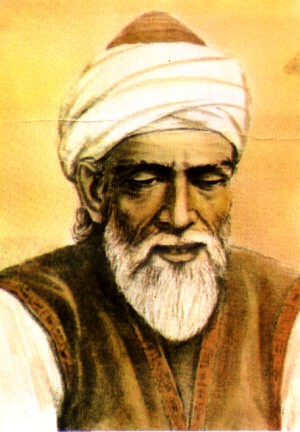Abu al-Wafa' al-Buzjani facts for kids
Quick facts for kids
Abu al-Wafa' al-Buzjani
|
|
|---|---|
 |
|
| Born | 10 June 940 Buzhgan, Iran
|
| Died | 15 July 998 (aged 58) |
| Academic background | |
| Influences | Al-Battani |
| Academic work | |
| Era | Islamic Golden Age |
| Main interests | Mathematics and astronomy |
| Notable works | Almagest of Abū al-Wafā' |
| Notable ideas |
|
| Influenced | Al-Biruni, Abu Nasr Mansur |
Abu al-Wafa' al-Buzjani (born June 10, 940 – died July 15, 998) was a brilliant Persian mathematician and astronomer. He lived and worked in Baghdad, a major city in the Islamic Golden Age. He made many important discoveries in math, especially in a field called spherical trigonometry. He also wrote about numbers for business people and was one of the first to use negative numbers in his writings.
Abu al-Wafa' created detailed tables for sine and tangent functions, which are important in trigonometry. He also helped introduce new math ideas like the secant and cosecant functions. His famous book, Almagest, was read by many astronomers for centuries after he died. He wrote other books too, but sadly, most of them have been lost over time.
Contents
His Life Story
Abu al-Wafa' was born in a place called Buzhgan, which is now part of Iran. When he was 19, in the year 959, he moved to Baghdad. He stayed there for the rest of his life, until he passed away in 998.
In Baghdad, he met and worked with other famous scientists of his time. He was supported by the Buyid court, which was like a royal family that helped scientists and artists.
Looking at the Stars: His Work in Astronomy
Abu al-Wafa' was the first person to build a special tool called a wall quadrant. This large instrument helped him observe the sky and measure the positions of stars and planets very accurately. He might have been inspired by another astronomer, al-Battani, who also wrote about a similar tool.
He used the idea of the tangent to solve problems about spherical triangles. These are triangles drawn on the surface of a sphere, like Earth. He also found a new way to calculate sine tables, making them much more precise than before.
In 997, Abu al-Wafa' took part in an interesting experiment. He worked with another scientist, al-Biruni, to figure out the time difference between Baghdad and Kath (a city in modern-day Uzbekistan). Their result was very close to what we know today, showing they were very good at their measurements!
His Famous Book: The Almagest
Abu al-Wafa' wrote many books about astronomy. One of his most important works is called Almagest. Only the first seven parts of this book still exist today.
This book talks about many different topics. It covers plane and spherical trigonometry, how planets move, and even how to find the direction of Qibla (the direction Muslims face for prayer).
Amazing Math Discoveries
Abu al-Wafa' made big contributions to trigonometry. He helped define the tangent function and introduced several trigonometric identities in the way we use them now. Before him, ancient Greek mathematicians used different ways to express these ideas.
Some of the important math rules he worked with include:
He also might have helped develop the law of sines for spherical triangles. This rule helps you find unknown sides or angles in a spherical triangle.
What Books Did He Write?
Besides his famous Almagest, Abu al-Wafa' wrote several other important books:
- Zīj al‐wāḍiḥ: This was a book of astronomical tables, but it is no longer available.
- A Book on Those Geometric Constructions Which Are Necessary for a Craftsman: This book has over a hundred ways to draw geometric shapes. It was very useful for craftsmen and builders.
- A Book on What Is Necessary from the Science of Arithmetic for Scribes and Businessmen: This is a very special book because it's one of the first medieval Islamic texts to use negative numbers. It helped people who worked with numbers in business and writing.
He also translated and wrote comments on the math works of other famous thinkers like Diophantus, al-Khwārizmī, and Euclid.
Why We Remember Him Today
Abu al-Wafa's work was so important that he has a crater on the Moon named after him! It's called Abul Wáfa.
On June 10, 2015, Google honored him by changing its logo to celebrate his birthday and his amazing contributions to math and astronomy.
See also
 In Spanish: Abu'l-Wafa para niños
In Spanish: Abu'l-Wafa para niños




